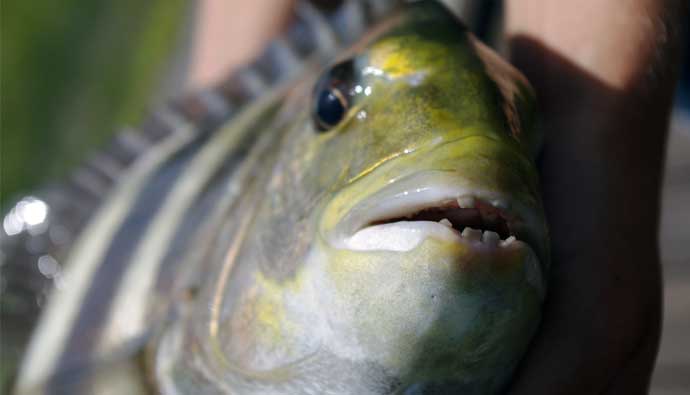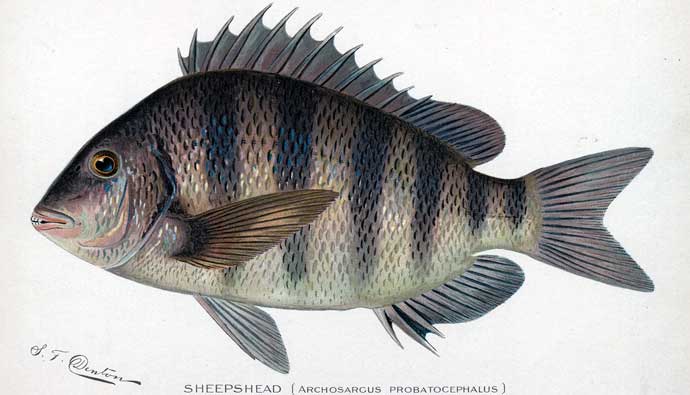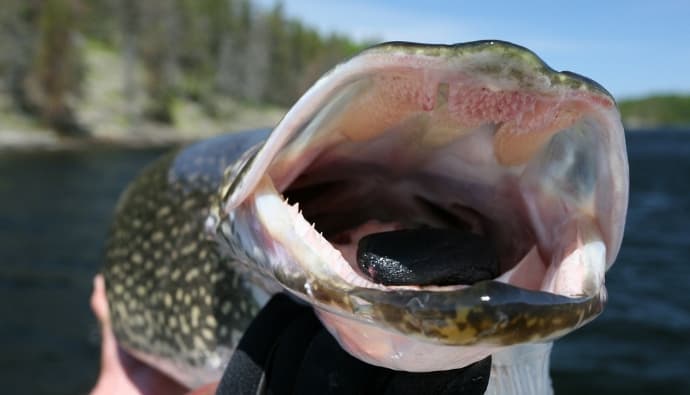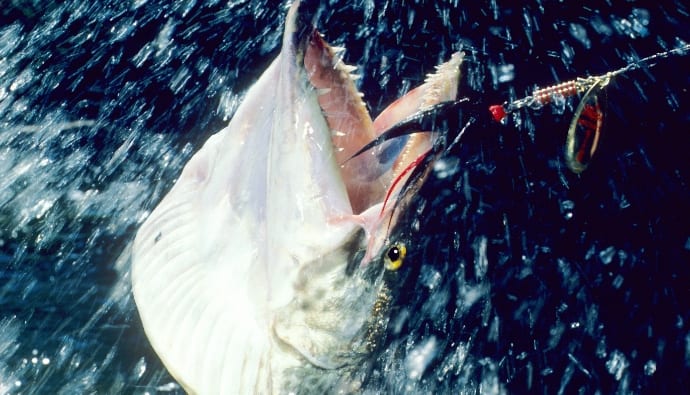Did you know there is fish that has a full set (and more) of human-like teeth?
Meet the sheepshead or sheepfish—this fish has a face straight from your nightmares. However, despite its somewhat hilarious appearance, it is considered a great catch by anglers.

In this guide, we’ll show you how to catch sheepshead for yourself!
Overview
Also known as the convict fish, freshwater drum, and sheepshead seabream, the sheepshead is the most powerful member of porgies. It has great commercial value as a food fish and is a favorite among saltwater anglers in the US. The fish can be caught around barnacle-encrusted structures along shorelines.
The sheepshead is predominantly black in color, but the sides and caudal peduncle are striped with broad silver and black bands. The mouth is small to medium in size, and the teeth are broad and flat, which it uses to crush the shells of crustaceans and mollusks while feeding.
This species occurs from Nova Scotia to Florida as well as in the northern Gulf of Mexico and southern Brazil.
Sheepshead Facts
| Scientific Name | Archosargus probatocephalus |
| Common Name(s) | Sheepshead, freshwater drum, convict fish, sheepshead seabream, southern sheepshead |
| Family | Sparidae |
| Identifying Characteristics | The fish is predominantly black in color, but the sides and caudal peduncle are striped with broad silver and black bands. The mouth is small to medium in size, and the teeth are broad and flat. |
| Depth Range | 15 to 60 feet |
| Habitat | This species occurs from Nova Scotia to Florida as well as in the northern Gulf of Mexico and southern Brazil. |
| Limits | Check your local regulations |
| Largest Recorded | 21 pounds |
Sheepshead Habitat
Sheepshead can be found swimming in bays and estuaries right along the shoreline. The fish also enters brackish water in coastal rivers at times and often travels in schools. As browsing feeders, sheepshead forage for food around the pilings of docks and wharves and may also be found around jetties, rocky bottoms, and in areas where oysters and mollusks are aplenty.
How to Catch Sheepshead

This fish is a fighter, so it is best caught on bait, on the bottom, or with float rigs, preferably with a light or medium tackle. The best bait for sheepshead is anything they love to feed on, such as shrimp, mussels, clams, crabs, or cut baits. Since the fish is known for being wary, use chumming to make it overcome its fear.
Sheepshead fish have a very light bite despite their massive teeth, and it has a habit of stealing bait. Make sure that the hook you use is sharp enough to set firmly in its hard mouth. Use a 6 to 7-foot medium-action rod that has a light touch so you can feel bites, and use a braided line that is limp and doesn’t end up in knots.
Convict Fish Fishing Tactics
- After casting your bait in front of this tricky fish, slowly lift the tip of the rod till you feel a bite. Rather than sticking your fishing hook there, though, wait till you feel the fish swimming away with the bait. Lift the tip of the rod, then allow the circle hook to set in firmly.
- Use lighter tackle if you are fishing for sheepshead inshore where there is little to no current, and use the heavier variety around submerged structures.
Sheepshead Fishing Tips
- Keep the tip of the rod up and make sure that the drag is not loose enough to wrap around submerged structures easily.
- For sheepshead bait, use crabs and barnacles as bait at the beginning of the season and shrimp as bait mid to late season.
- These fish with big teeth are also known as bait stealers. Pay attention or find yourself replacing your bait often during your session.
Spearfishing Sheepshead

- Florida sheepshead flees fast when they are spooked, so use a speargun that tracks quickly and has little drag when it is moved from side to side.
- Since you will be spearfishing in close quarters in shallow and brackish water, use a shorter band gun or try a pneumatic one. If you have a quality pole spear, that’ll work too.
Sheepshead Seasons
Catching convict fish can be done all year round in Florida bays and estuaries right along the coastline. That is where the fish remains during summer, spring, and fall. Large and mature sheepshead migrate to offshore spawning grounds in winter.
The fish is active in West Michigan during the early summer months, but activity is low during late June and early July in the region.
How to Clean Sheepshead Fish
- Lay the fish flat on a cutting board and use a sharp filleting knife to cut along the backbone freeing the fillet from the rib cage. Work the knife up to the head and remove the chunk of meat there.
- Continue by cutting along the dorsal fin down to the tail and removing the meat from the tail section.
- Cut the meat away from the bones all the way to the rib cage and from around it.
- Make a vertical cut behind the head and hold your knife at a 45° angle to cut under the scales. Cut all the way to the backbone to about the fish’s eye level. This should free up a fillet. Flip and repeat on the other side for the second fillet.
How to Cook Sheepshead
Sheepshead Recipe
- Melt one and a half tablespoons of butter in a medium-sized skillet over medium heat.
- Add the fillets and cook for 3 to 5 minutes on each side till it turns brown and flaky.
- Sprinkle seasoned salt, paprika, and tarragon on the cooked fish.
- Sprinkle lemon juice on top and serve with lemon wedges.
- Sheepshead fish-eating is a treat!
FAQs
The flesh of the sheepshead is bony but not meaty, either.
The fish has large, broad, and flat, which is used for crushing and chewing shells. The teeth are almost human-like, and it actually starts to develop molars at the back of the jaw when it grows into an adult.
This fish can grow to about 3 feet in length and can weigh over 25 pounds. On average, the fish grows about a pound in weight.
Insider Advice
The saltwater sheepshead is a great commercial value and puts up a fight that makes it a favorite with anglers. Do you have any tips, tricks, and strategies that worked while you were angling for this fish?
Share your answers in the comments section below and share this guide if you liked it.
Read Also: How to Catch Tautog Fish




 Facebook
Facebook YouTube
YouTube









